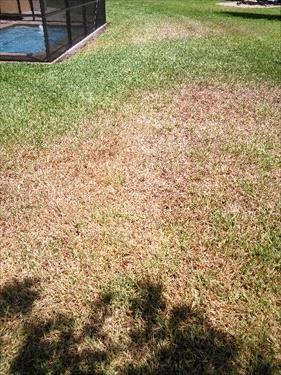Your Cart

Summer 2022
Jun 27, 2022
![]()
Dry, Dry, Dry

After what started out as a drought-ridden May, we thought we were going to get into our usual thunderstorm weather pattern and finally get some much-needed rain. NOAA published in early June that SC would need between 7-10” by the end of June (depending on where you are) to catch up for our lack of rainfall this year. Unfortunately, the rain hasn’t come…consistently enough, anyway. If you’ve been watering a bit too shallow, there’s too much thatch, or you have poor soil quality, your lawn is probably experiencing dry stress.
What does dry stress look like? The blades of the grass will start to curl inward and the grass might have a gray/blue-ish hue to it. When you walk on the lawn, your footprints will remain as the grass doesn’t have enough oomph to stand back up.
So what are we seeing? Lots and lots of dry and heat stress on lawns that don’t have irrigation and lawns that do. During a drought, sometimes the plant will simply go dormant (back to brown, just like winter) because it isn’t getting enough water to complete the photosynthesis process (create chlorophyll and be green!). Lawns that have irrigation might be finding out that their sprinkler system doesn’t have even coverage or different areas of the lawn are requiring different amounts of water. Roots that are growing in too much thatch are crying “uncle” at this point because the roots aren’t protected in the soil.
Where do you see your dry stress? We bet most of y’all are seeing dry stress adjacent to concrete and asphalt. Those areas retain much more heat throughout the day and night and will show more summer stress than other areas of the lawn. Maybe you see your dry stress right smack in the middle of the lawn where an old tree stump used to be. Or, maybe you see your dry stress stretching 20’ across your front yard because the builder put the slag rock for the temporary driveway on the wrong side of the lot and there are still lots of rocks in the soil. There are so many reasons.
There isn’t much that can be done in regards to heat stress, because the outside temperature is essentially cooking the plant. Luckily, there are some things you can do to help with dry stress.
- Water! – water thoroughly in the morning hours. If your lawn IS NOT experiencing dry stress, watering 2-3 times per week, getting ½” of water on the lawn should be sufficient. If your lawn IS experiencing dry stress, try watering every other day for a week, getting ½” – ¾” of water on the lawn each time. You should see some improvement. The areas that are harmed by the heat/dry stress will be vulnerable and weak throughout the rest of the summer which means those areas might have a hard time next spring…as in spring 2023. There is still a chance for recovery if the weather permits.
- Consider adding a compost such as cotton burr compost at around ½” in depth (spread it around with the BACK of a rake so not to pull up the stolons/runners of the grass plants). Organic matter helps our often poor-quality soil by adding extra nutrients and allowing the soil to hold on to extra moisture.
- Say a prayer for a “normal” amount of rain or do a rain dance. Don’t dance so much, though, that we get TOO much rain. Just ask for 1-1.5” per week. We’re urban farmers – turf is our crop!
Any questions? Give us a call at 843-884-1006
